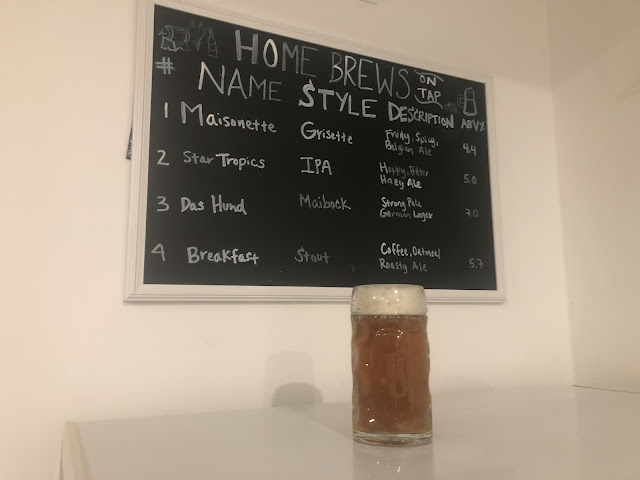I was recently extremely intrigued and inspired by the Chop and Brew episode on a beer made with 100% alder smoked malt. While I had kept up with Lars Garshol's blog for years, I had not thought a lot about Norwegian farmhouse styles since brewing a few beers with kveik a few years ago and had fallen behind on my reading. For one thing, I missed that Lars had released a book. For another, I missed how readily available many strains of kveik had become. Maybe what surprised me the most about the video though, was how there was suddenly the ability to buy malts made in the traditional Stjørdal style in the U.S. Within a day or two of watching the video I had placed an order with Sugar Creek Malt Co. and ordered Traditional Farmhouse Techniques so that I could set out on making a beer in this style for myself.
The book arrived first and it did not disappoint. An absolute page turner of history, culture, techniques, and ideas that, despite having read Lars' blog for years, felt new and exciting. I would easily put it in the top few beer/homebrewing books that I've ever read and feel that the information included, and the writing quality in terms of both style and clarity, are top notch. I tore through the book cover to cover and plan to go back to it again regularly.
 |
| Mash hops and the (non-traditional) juniper berries about to be added |
When the malt arrived I was finally ready to make a Stjørdalsøl inspired beer and put together a very simple recipe of 9.5 lbs Stjørdal malt from Sugar Creek, 1.5 lbs of white sugar, and 1 oz of Hallertau Mittelfrüh. One half of the batch was fermented with a kveik strain (in this case Omega's Voss Kveik), making it (hopefully) close to a traditional Norwegian style. I had originally planned to ferment the other half with a lager yeast to make it closer to a traditional German Rauchbier to give myself a reference point for the flavor of the smoked malt, but after reading the book I was inspired to instead go with a Baltic (specifically Lithuanian) yeast strain in an effort to emulate a historical Gotlandsdricke. While Gotlandsdricke is a fairly different, and very geographically distinct, style it shares some commonalities in that it is a dark, smoked, farmhouse beer often made with juniper that was historically made with a farmhouse yeast so while this recipe might be farther from that style it should be in the ballpark. I had also wanted to try out the Jovaru yeast since it was first released but had not yet had an opportunity. Perhaps the most inauthentic part of this recipe was the use of Juniper berries rather than branches, but it was the closest thing I could easily procure and with the smoked malt being such a driver of the flavor I'm hopeful this won't cause a huge departure from the true flavors of these styles.
 |
| 9.5 of the 10 pounds were used in this recipe with the hope to save the last half pound for a future brew |
 |
| Beautiful light brown color on the smoked malt and a huge aroma that fills the room |

 1/29/22
1/29/22
Fittingly cold and snowy brew day for Nordic inspired beer(s). Milled 9.5 pounds of Stjørdal malt on my father's mill. Mashed in at 154F and added half an ounce each of hops and juniper berries. Ran off after an hour rest, added sugar to first runnings and stirred, then put on burner and began heating during sparge. Sparged at 180F, added second runnings to kettle and brought to boil. Added the second .5 oz. dose of hops after about 15 minutes of boiling then boiled for another 60 minutes before chilling. Chilled to low 80s, ran into two separate 3 gallon fermenters and pitched separate yeasts. Placed next to each other and wrapped in towels in a fairly cool basement; hopefully they can rip through fermentation before their temps fall too much.
2/6/22
Fermentation very slow if still active but still a thin krausen.
2/17/22
No noticeable fermentation, should probably be packaged by now but currently between houses and this is staying at my parents' house while my equipment is in storage.
3/2/22
Kegged in separate 3 gallon kegs. Taste of both pre-carbonation is very smokey and interesting. Camp fire, pine, cherry, and interesting fruitiness all come through in both with the "Gotlandsdricke" version being dryer and emphasizing the pine and a touch more spicy phenols. TBD whether I carbonate and serve on draft or transfer to bottles.
3/18/22
Bottled both halves. 2/3s of the Stjørdalsøl version was left with the very low (~5 PSI at room temperature) carbonation while the other 2/3s (labeled Stj) received one Cooper's carbonation drop. All of the Gotlandsdricke bottles (except for a couple of 12 oz bottles) received one carbonation drop.
3/23/22
Brought a bottle of each of the low carbonation versions to a DC Homebrewers meeting on 3/19 and one bottle of the low carbonated Voss version to a BADASS meeting. Very well received in terms of it being interesting but not a beer that everyone necessarily enjoyed. Both versions are aggressively smokey with some interesting pine and fruit character. I find the Voss/Stjørdalsøl version has more cherry and citrus while the Jovaru/Gotlandsdricke version is a touch drier and more phenolic, though some felt it was less smokey and very different from the Voss. The phenol level is so high that it occasionally comes across to me as medicinal and chloraseptic-like but in small pours the beer is highly interesting and enjoyable. Hoping to do a more thorough tasting in the future.
4/13/22
Tasting Night, tasting notes above. Tasting notes were done on a small bottle of the low carbonated version of the Voss/Stjørdalsøl version. I may revisit in the future with a higher carbonated bottle or the Gotlandsdricke/Jovaru version.




















